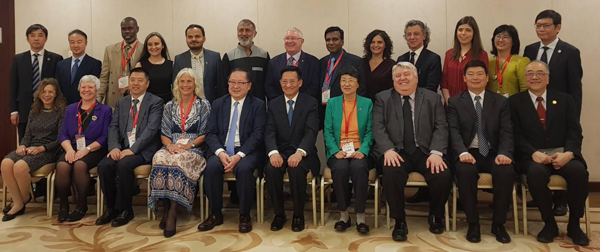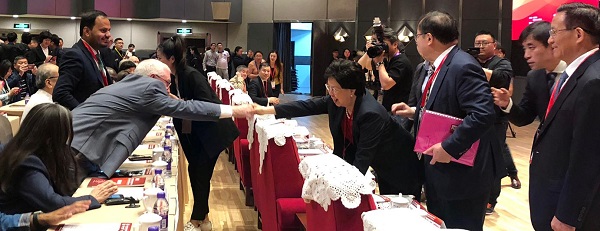In my view... May 2019
 Photo: WONCA Executive and Chinese colleagues in Beijing during April.
Photo: WONCA Executive and Chinese colleagues in Beijing during April.
Español 中文
Donald Li, WONCA President, writes:
There is a view that says we can hold most of our business meetings using apps such as skype and go-to-meeting and zoom. It is useful to be able to see colleagues and to observe their expressions when in discussion. There is a good argument that such meetings are time-efficient, in that people can participate from wherever they are working, with minimal disruption to their working day. There is also the argument that reducing the carbon footprint from multiple flights, train and car journeys is a ‘good thing’, contributing to a better, safer environment. But nothing can really match the level of engagement possible through direct face to face meetings.
In April, the Chinese Medical Doctors Association (CMDA) invited WONCA to hold their Executive meeting in Beijing, to coincide with the annual conference for general practitioners which attracts more than 2,500 attendees from all across China. This was the first face to face meeting of your new Executive since they took up their positions in Seoul in October 2018. Of course, we have had numerous teleconferences in the intervening period and a few of Executive have met when attending WONCA conferences in the regions. However, the level of engagement and the amount of interaction which was possible through the face to face meeting of Executive reinforced just how important personal interaction really is. As family doctors we are all well aware of this, even with the advantages of improving technology and the potential for remote consultations or training or diagnosis.
WONCA Executive members are currently appointed for two years; many of the regions have gone to single terms (two years) for their regional presidents. Executive only meets face two face twice in each year. This means there is very little time for Executive members to get to know each other, to learn about how WONCA World functions, to get to grips with their responsibilities on Executive – and then get on with the business of making decisions and undertaking work on behalf of WONCA. Face to face meetings are crucial to develop the collegiality, mutual recognition and respect necessary to encourage a well-functioning and effective Executive.
Watching Executive members work together collaboratively, listen to and learn from each other about how things work in the different regions, discuss and decide on priorities and how to implement them, was both exhilarating and humbling. We know there is much work to be done but together we are raising the profile of WONCA globally, using targeted approaches, reinforcing the same messages about the importance of family medicine. That face to face interaction, building collaboration, which Executive enjoyed in Beijing will serve us well as we continue our work.
 Photo: Donald Li speaks at the CMDA conference watched by other WONCA Executive members
Photo: Donald Li speaks at the CMDA conference watched by other WONCA Executive members
At the CMDA conference with which our meeting coincided every member of Executive was invited to speak. Region Presidents were able to provide some background and information about the regions they represent; Members At Large offered their insights into key activities of WONCA (such as our liaison with WHO and Rural Health); the Immediate Past President offered her views on global trends in medical education; while the CEO gave a brief overview of WONCA’s Practice Accreditation programme, which some Chinese practices have already been awarded.
 Photo: WONCA CEO and Dr Margaret Chan reach out to greet each other at the conference.
Photo: WONCA CEO and Dr Margaret Chan reach out to greet each other at the conference.
CMDA conference delegates were enthusiastic about what the WONCA Executive members presented and they took every opportunity possible to follow up on their particular areas of interest over the next days. Equally, Executive members followed up on a whole range of topics addressed in the conference on policies and innovations in Chinese family practice development. This is the way lasting professional relationships are built, cross-referencing experiences, building on knowledge.
We will, of course, embrace digital technology and make the best use possible of it for ourselves and our patients. But nothing will ever take the place of face to face discussion and interaction as a way to build trust, respect, understanding and warmth.